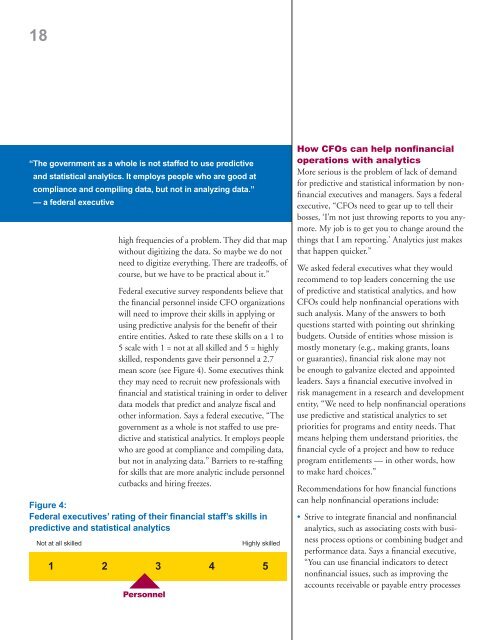CFOs: Surviving in a New Era - AGA
CFOs: Surviving in a New Era - AGA
CFOs: Surviving in a New Era - AGA
You also want an ePaper? Increase the reach of your titles
YUMPU automatically turns print PDFs into web optimized ePapers that Google loves.
18<br />
“The government as a whole is not staffed to use predictive<br />
and statistical analytics. It employs people who are good at<br />
compliance and compil<strong>in</strong>g data, but not <strong>in</strong> analyz<strong>in</strong>g data.”<br />
— a federal executive<br />
high frequencies of a problem. They did that map<br />
without digitiz<strong>in</strong>g the data. So maybe we do not<br />
need to digitize everyth<strong>in</strong>g. There are tradeoffs, of<br />
course, but we have to be practical about it.”<br />
Federal executive survey respondents believe that<br />
the f<strong>in</strong>ancial personnel <strong>in</strong>side CFO organizations<br />
will need to improve their skills <strong>in</strong> apply<strong>in</strong>g or<br />
us<strong>in</strong>g predictive analysis for the benefit of their<br />
entire entities. Asked to rate these skills on a 1 to<br />
5 scale with 1 = not at all skilled and 5 = highly<br />
skilled, respondents gave their personnel a 2.7<br />
mean score (see Figure 4). Some executives th<strong>in</strong>k<br />
they may need to recruit new professionals with<br />
f<strong>in</strong>ancial and statistical tra<strong>in</strong><strong>in</strong>g <strong>in</strong> order to deliver<br />
data models that predict and analyze fiscal and<br />
other <strong>in</strong>formation. Says a federal executive, “The<br />
government as a whole is not staffed to use predictive<br />
and statistical analytics. It employs people<br />
who are good at compliance and compil<strong>in</strong>g data,<br />
but not <strong>in</strong> analyz<strong>in</strong>g data.” Barriers to re-staff<strong>in</strong>g<br />
for skills that are more analytic <strong>in</strong>clude personnel<br />
cutbacks and hir<strong>in</strong>g freezes.<br />
Figure 4:<br />
Federal executives’ rat<strong>in</strong>g of their f<strong>in</strong>ancial staff’s skills <strong>in</strong><br />
predictive and statistical analytics<br />
Not at all skilled<br />
1 2 3 4 5<br />
Personnel<br />
Highly skilled<br />
How <strong>CFOs</strong> can help nonf<strong>in</strong>ancial<br />
operations with analytics<br />
More serious is the problem of lack of demand<br />
for predictive and statistical <strong>in</strong>formation by nonf<strong>in</strong>ancial<br />
executives and managers. Says a federal<br />
executive, “<strong>CFOs</strong> need to gear up to tell their<br />
bosses, ‘I’m not just throw<strong>in</strong>g reports to you anymore.<br />
My job is to get you to change around the<br />
th<strong>in</strong>gs that I am report<strong>in</strong>g.’ Analytics just makes<br />
that happen quicker.”<br />
We asked federal executives what they would<br />
recommend to top leaders concern<strong>in</strong>g the use<br />
of predictive and statistical analytics, and how<br />
<strong>CFOs</strong> could help nonf<strong>in</strong>ancial operations with<br />
such analysis. Many of the answers to both<br />
questions started with po<strong>in</strong>t<strong>in</strong>g out shr<strong>in</strong>k<strong>in</strong>g<br />
budgets. Outside of entities whose mission is<br />
mostly monetary (e.g., mak<strong>in</strong>g grants, loans<br />
or guaranties), f<strong>in</strong>ancial risk alone may not<br />
be enough to galvanize elected and appo<strong>in</strong>ted<br />
leaders. Says a f<strong>in</strong>ancial executive <strong>in</strong>volved <strong>in</strong><br />
risk management <strong>in</strong> a research and development<br />
entity, “We need to help nonf<strong>in</strong>ancial operations<br />
use predictive and statistical analytics to set<br />
priorities for programs and entity needs. That<br />
means help<strong>in</strong>g them understand priorities, the<br />
f<strong>in</strong>ancial cycle of a project and how to reduce<br />
program entitlements — <strong>in</strong> other words, how<br />
to make hard choices.”<br />
Recommendations for how f<strong>in</strong>ancial functions<br />
can help nonf<strong>in</strong>ancial operations <strong>in</strong>clude:<br />
• Strive to <strong>in</strong>tegrate f<strong>in</strong>ancial and nonf<strong>in</strong>ancial<br />
analytics, such as associat<strong>in</strong>g costs with bus<strong>in</strong>ess<br />
process options or comb<strong>in</strong><strong>in</strong>g budget and<br />
performance data. Says a f<strong>in</strong>ancial executive,<br />
“You can use f<strong>in</strong>ancial <strong>in</strong>dicators to detect<br />
nonf<strong>in</strong>ancial issues, such as improv<strong>in</strong>g the<br />
accounts receivable or payable entry processes
















